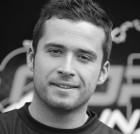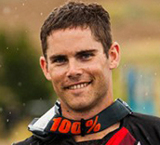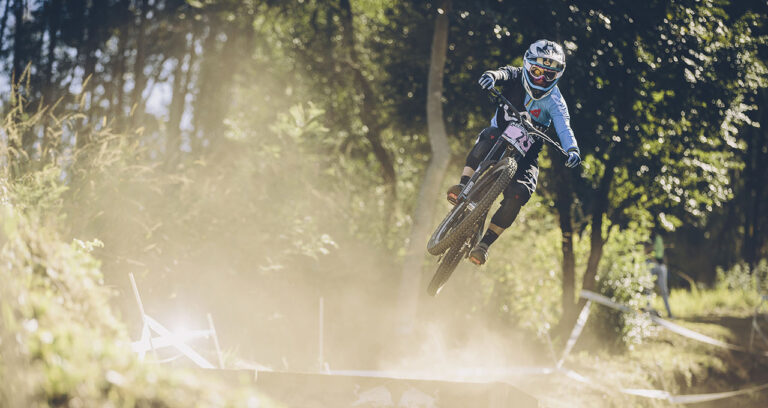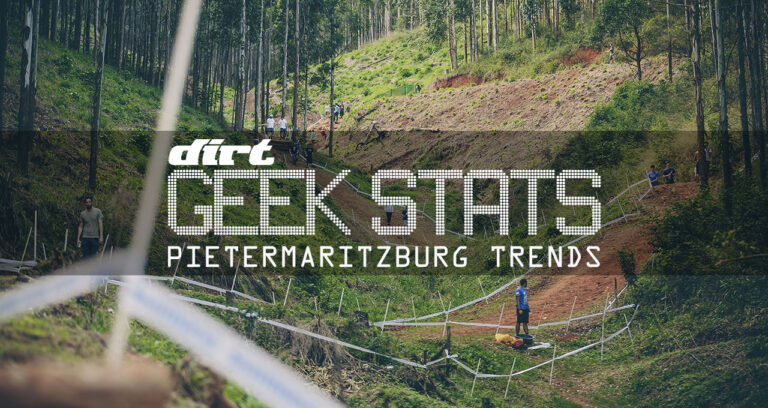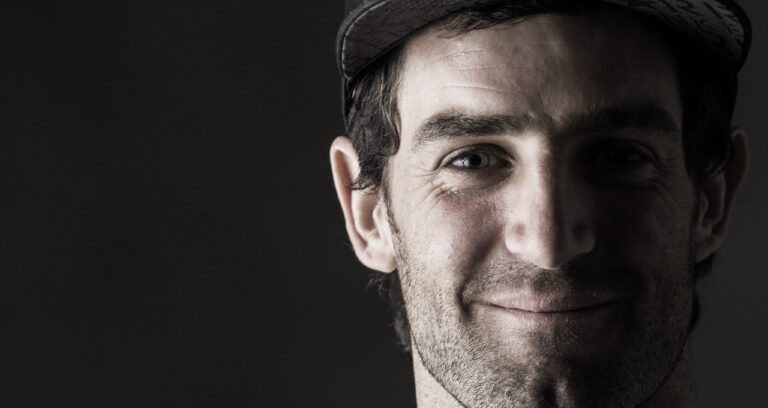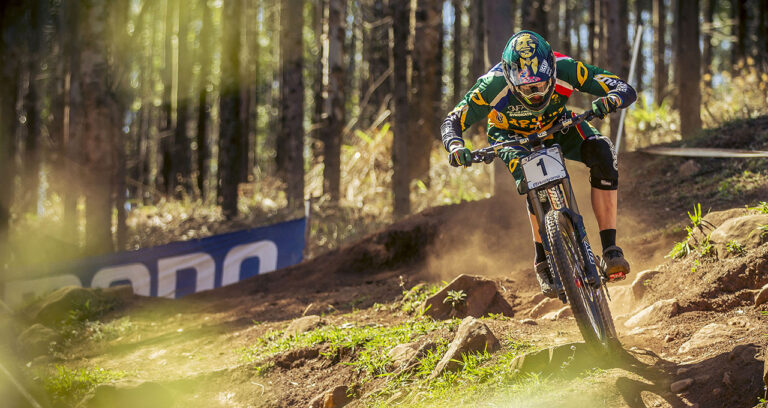Feature by Paul ‘I’m on a massive summer holiday in NZ’ Haysom
Working on the gondola here in Queenstown, NZ, I see a lot of bikes every day. Some of the best riding in the world coupled with hot and bluebird days mean more riders than ever are choosing to spend their off seasons on the other side of the planet. The Hutchinson United Ride team are some of the most familiar faces here and have been coming to Queenstown for a few years now.
So when Fabien ‘Cous Cous’ Cousinié, owner/manager of Hutchinson UR, rolled through the gate with a completely different bike, it turned a few heads. We’ve had the new Lapierre downhill bike and the new Devinci go up the hill, but this bike seemed to be a total re-design of the bike the team was riding last season. I headed to a quieter part of the hill to find out more from the team owner.
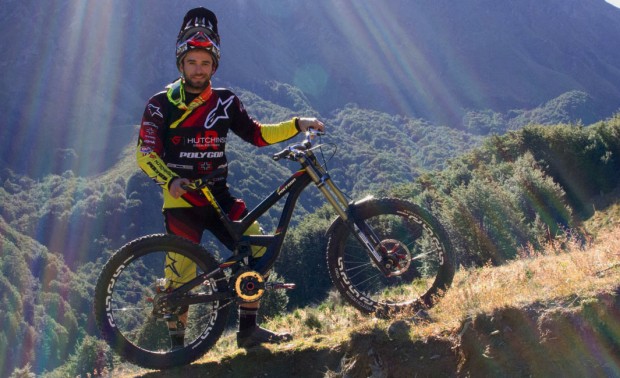
Cous Cous with his latest Polygon DH bike.
Paul Haysom: It seems like Polygon have only been on the high-end bike scene for a short time, you raced a new bike last season and now there’s already a new model. Why so?
Cous Cous: Polygon have only just entered the game of high-end bikes. They were quiet on the market before as they were mainly sold around Southeast Asia and Australia really – but one and a half years ago they decided to give the quality of their range a boost and that’s why the team is sponsored by Polygon; to develop new bikes, give feedback and show what they are capable of.
PH: You’ve only had one season on the previous incarnation of the Colossus and now you are already developing a new model that looks completely different!
CC: We are on a pretty intense developing process since the day the team signed. This is actually the third prototype of the DH bike. Let’s say we tested the one that is for sale and we liked it, so the first step we took was evolve the geometry on the first prototype, making it a bit slacker. Then we took this Colossus prototype and we changed some bit of the kinematics to make it more suitable for World Cup riding. This bike that you see is the third generation, which comes after some more kinematic adjustment to see we if could fix the bits we could not get right before. It’s a pretty intense development and it’s unique for downhill that a company produces so many prototypes, it’s a good process of development to see what works best.

Putting in the hours. All in the name of development of course.
Ph: It’s clear to see that the linkage is completely different from the Colossus that was for sale. What specifically were you looking to get from the bike?
CC: Kinematics is always a bit of a compromise, because it’s hard to get everything perfect as some parameters might not be working together perfectly. We tried to get better pedalling, a lighter construction and a more controlled, progressive stroke. I’m not going to go in to too much detail, it’s very complicated. It’s all about getting the balance between pedalling, light weight, progressivity and how the suspension reacts to things like braking bumps. It’s all about improving. There’s a lot of good bikes on the market and it’s all about achieving perfection for us and our racing.
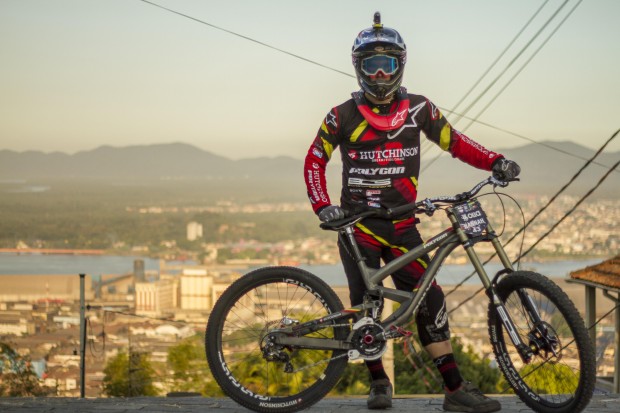
Team rider Mick Hannah with his latest race bike. He blitzed qualifying in the Aussie Nationals last week on this.
PH: Let’s talk about the suspension. From Fox to BOS this season. What led this decision?
CC: It’s a little bit of everything. With Fox we had some great years and they have lots of other great riders using their products. As a team we needed to grow and with Fox tied up with all the other teams we could not find the package that we were looking for, but we are still friends! With BOS we did some testing with other suspension brands and their forks were working really well. They were the first suspension sponsor of the team back in 2009/10 when I started the team. The testing with them was awesome and they have new projects for working with racing that are proving successful. We’re going to be the top team for them with a lot of development focus on us. Plus they are just one hour down the road!
Paul’s Ghetto Gallery – a few of the bike’s details.
PH: What’s different about the internals on your forks as opposed to production? Guillaume [Cauvin] has said his bottom-out ramps up much harder than off-the-shelf models. Are you running something similar?
CC: We can’t really talk much about the details of what that is. [Laughs.] There’s a lot that’s in development. Just on the bottoming out aspect there is pretty much an independent suspension only for the end of the travel, let’s say. Let’s say you set up for suspension for how you ride, then we are testing another part you set up just for the bottom out, independent of the other aspects of the fork. It’s pretty good when you huck to flat!
PH: Let’s talk about the geometry. It’s a big talking point with other manufacturers.
CC: Geometry is like cooking – it depends what your tastes are, I think. There is no ultimate truth, we just try to suit each rider’s style. We approach the design not just focussing on the geometry, but the bike as a whole – how the suspension reacts, how the kinematics work – which affects the geometry that you wanted. But we got a bit slacker head angle, low BB and tried to get it fast and to grip really well.
PH: Longer reach, shorter chainstays it seems on the better bikes out there. Is that what we are seeing here?
CC: We have an adjustment on this bike that makes the chainstay 435 to 445. 1cm is a big change so we have chosen to have either quite short or quite long. We probably change handlebar height more, a higher front end is more comfortable.
PH: Got to talk about it – these prototypes seem to be 26”…
CC: Yes they are!
PH: Is it worth testing 26” with how the industry is going?
CC: We are open to everything and will work with any option. It’s a matter of timing and not rushing out to get a different size of wheel for a bike that’s not designed for it and don’t have all the parts that are perfect for it. We are testing a lot of stuff right now and decisions will be made right before the World Cup. We are going to rely on the timing, see what that says, and when we have everything ready we will go with what comes up the fastest. You can do some testing in November when you are not fit and not as trained and think “oh yeah, this is good”. Then when the rider has hit peak shape in March they ride differently. I think it’s best to make a decision when the rider is closer to race condition.
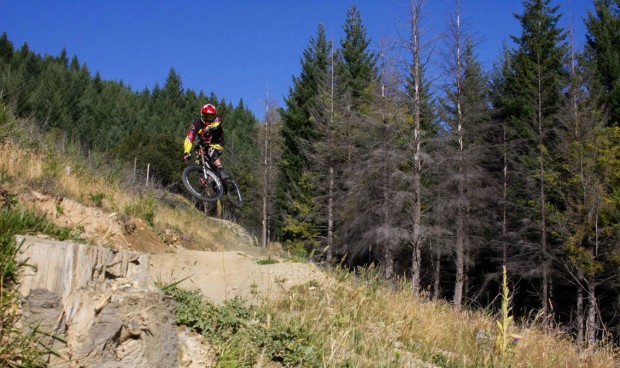
Sending one in the southern summer.
PH: Different brand of wheels this year too, from Mavic to e*13.
CC: They’ve been a partner of the team for a few years now, every year they wanted us to ride their wheels and this year they offer us a really awesome development package – things like custom wheels. The products that they have already are super competitive and the innovations that are coming… well I can’t tell you that! We rode their cranks last season and from this there’s some new projects that are coming from what we helped with. It will be the same for the wheels. It’s a really light performing wheel, so we are saving weight.
PH: Something that really sticks out is the mudguard on the front. Possibly just as much innovation in this area of the market as suspension in recent times..?!
CC: Yeah! This is a prototype Zefal model that we are working on right now, then it will be up on the market once we find something that we like. Trying to take the best aspects of what’s out there. Something a bit stiffer and larger is what this will be. This is a 3D printed prototype, but it will be made via injection moulding so it will be even stiffer. But I am a huge fan of 3D printing.
PH: And of course the tyres. Main team sponsors.
CC: The tyres we have experimented with a number of compounds, but out of everything this is the thing we have changed the least. This tyre, the Toro 2.5, is good for dusty and wet bike park riding, but still works well in the dry. It might not roll the fastest but it performs well in all conditions I find. If I don’t have to change them all the time it makes my life easier.
You can do some testing in November when you are not fit and not as trained and think, “oh yeah, this is good.” Then when the rider has hit peak shape in March they ride differently.
PH: You talk about developing the products as a team, but surely you’re all pretty different riders? How can you reach a decision? Is everyone’s opinion equal?
CC: Myself, Guillaume and Mick are all pretty much the same size. It helps a lot with the length of the bike because we all use the same frame. Of course some of us have shorter legs, longer arms – but geometry wise we are pretty much on the same set up. It’s mostly suspension set up that affects the geometry. Everyone gives different inputs, with different opinions of what they like and we all give it a try, but we always come back to the same idea of how the bike should be set up. It’s funny but we aren’t that different in how we set up the bike, except Tracey of course because she’s way shorter than us – but she still rides hard!
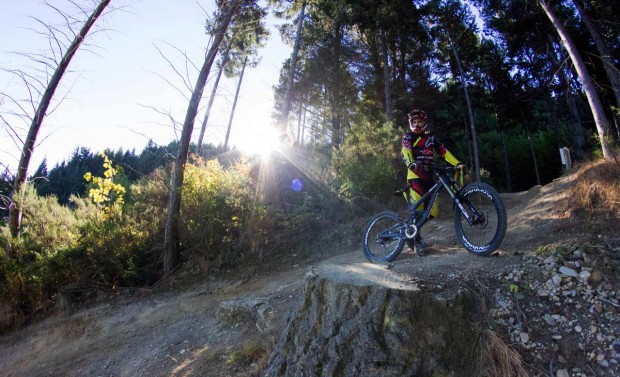
PH: What about yourself, are you going to be racing every world cup this year?
CC: I have a pretty crazy schedule, but I’m meant to do all the World Cups and all the Enduro World Series rounds. There’s one that clashes – Windham or Crankworx. So far I’m registered for everything, but I’ll see where I’m needed most. It’s hard to manage the team and still try to set goals like top 10 results. This year though I’ve taken my training over the winter to have fun, I mean I still do physical stuff, but I will take the racing as a bonus and see how it goes. We’ve developed the enduro side of the team too so it’s always good if I can go to the races and represent. It’s going to be crazy!
PH: So is it more important to get a result or to be able to give good feedback about what you feel from the bike?
CC: From my position, we have riders that are getting results. So that part has been taken care! Development is my priority and if I do well then it’s a bonus. Like in 2012 when we got the best team at Pietermaritzburg. As a racer I know how hard it is to get a result, no matter how much you want it. I want to make sure the team is giving their best at all times and not wasting opportunities messing around; as long as they train hard and give 100% I’m happy. Sometimes you might not get the right result – it’s part of racing. We have a super solid media crew following us, so if the results don’t go our way we can still give something to the sponsors.
PH: You’ve added a team photographer to your filmer, Jean-Baptiste Bazzarini (the man behind “A Racer’s Dream”)
CC: Yes JB has been with us full-time for two years, now we have Kevin Triboulat. So the team is a media production team as well as a racing team.
PH: Men and Women’s title this year?
CC: Always the plan! I think the schedule suits our racers, as well as our enduro team and slopestyle team. We have some of the best products here and all the possibilities to make the best bike.
PH: Last question – when can the public buy this bike?
CC: No idea! Keep an eye on the team’s Facebook page and Polygon Facebook. The new DH won’t come out before we have the best product possible though.

